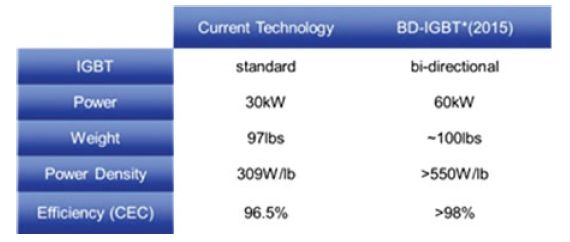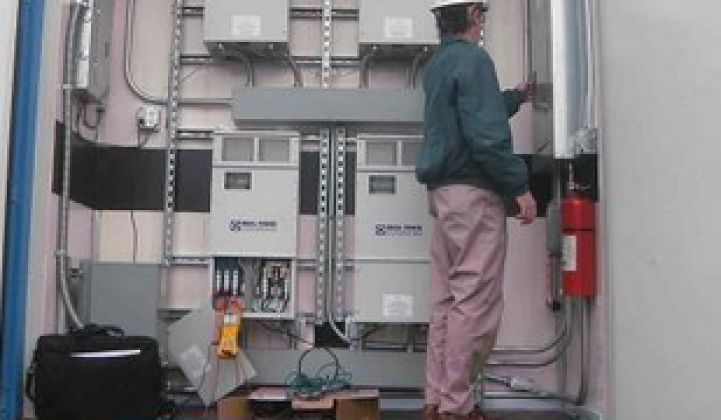Early last year, we covered Ideal Power and its new class of power converter technology, one that promises some significant advantages over competing inverters for connecting solar panels, batteries, electric-vehicle chargers, and other endpoints of the grid edge.
As with any emerging technology, Ideal Power’s Power Packet Switching Architecture (PPSA) faces some high hurdles in proving that it can achieve its lab-tested high efficiencies in real-world deployments. Getting past pilot projects and into commercial-scale work is particularly important for the Austin, Texas-based company, as it’s seeking to shift from contract manufacturing to technology licensing to turn the relatively small amount of capital it has raised -- $25 million or so -- into the foundation for a profit-making standalone business.
But over the past 12 months, Ideal Power has made some significant strides, landing multiple partners to put its 30-kilowatt and 125-kilowatt, two-port and three-port power converters to use in multiple configurations. Last year, it won orders to support lithium-ion battery-based “mobile hybrid power systems” from EnerDel and battery-backed solar PV systems from Sharp, as well as for new pilot projects from hybrid zinc cathode battery startup Eos Energy Storage.
And this year, Ideal Power announced partnerships with two deep-pocketed players in the energy storage field. The first, South Korean lithium-ion battery giant LG Chem, will jointly develop commercial demand charge reduction and microgrid applications using its batteries and Ideal Power’s converters. The second, international electronic equipment distributor Rexel Holdings USA Corp., has added Ideal’s power converters to the product portfolios of subsidiaries Rexel in France, and Gexpro, General Electric’s former GE Supply business, in the United States.
The Rexel/Gexpro deal is particularly interesting, as it could allow Ideal Power’s devices to become available, alongside those of brand-name companies like ABB, GE, Tyco and LG Electronics, to a broad class of buyers looking for standardized components for what’s still a nascent grid-scale energy storage market, Dan Brdar, president and CEO of Ideal Power, said in an interview last month.
“They have been looking at what appears to be significant growth coming in storage, and they want to have a role in that,” he said. “We’re happy that they chose us for this important market.”
As for LG Chem, it has done plenty of grid-scale energy storage work, including Southern California Edison’s 8-megawatt Tehachapi wind power battery project, and it is a partner of AES Energy Storage’s Advancion business for pre-integrated, megawatt-scale energy storage projects.
But as Ryan O’Keefe, Ideal Power’s senior vice president of business development, pointed out in a recent interview, the battery giant hasn’t yet done a lot of work in the market for behind-the-meter battery systems for commercial and industrial customers. On that front, LG Chem's work with Ideal Power could represent “their...endorsement of our technology” for this growing energy storage market opportunity, he said.
All told, last year saw Ideal Power receive purchase orders for about 9.5 megawatts of its battery and hybrid power converters, along with another 1 megawatt worth of orders to stock Gexpro warehouses, according to its 2014 financial results released earlier this year (PDF). In a highly unusual move for a company of its size, Ideal Power held an initial public offering in December 2013, raising $17.5 million to add to its $1 million grant from the Texas Emerging Technology Fund in 2010, an ARPA-E grant of $2.5 million in 2011, and $4.75 million in convertible debt financing in 2012 from backer MDB Capital Group.
A growing partner and product list -- but not much time to reach its long-term goals
As its 2014 annual report shows, Ideal Power is still losing money, even as it expands its share of revenues from product sales. The company’s 2014 revenues grew to $1.79 million, including product revenues of $1.2 million and $579,000 in ARPA-E grant revenue, compared to 2013’s revenues of $1.89 million, consisting of $417,000 in product revenues, $100,000 in royalty revenues and $1.375 million in ARPA-E grant revenue.
The company’s net loss of $6.9 million last year was an improvement from its 2013 net loss of $9.6 million, but still represented a significant outflow of its remaining cash reserves. The company spent $5.5 million in cash for operations and $760,500 for patents, property and equipment in 2014, and ended the year with $7.9 million in cash and equivalents.
Still, Ideal Power expects its current cash reserves to be enough to meet its operating plan for this year, according to its 2014 annual report. The company reported a backlog of $2 million at the end of last year, and with this year's first-quarter sales roughly equivalent to its entire 2014 sales, “in 2015, we’re clearly at an inflection point,” Brdar said.
Some important milestones on this path will include growing its share of opportunities in the still-nascent energy storage system and microgrid markets. Ideal Power’s key technical advantages -- smaller size and weight, and a novel indirect power transfer process that can maintain high conversion efficiencies across widely varying rates of charge and discharge -- aren’t as apparent in head-to-head matchups against other solar PV inverters, where power flows in one direction at a fairly steady rate.
But for battery systems that require different levels of power flow in two directions, or in microgrid configurations that route power back and forth amongst multiple devices, they could become significant differentiators.

At least that’s what Brdar hopes the company will prove as it expands its product line from 30 kW to 125 kW power converters, allowing them to support configurations up to a megawatt in size, and finds more customers for its three-port products, which could help designers of multi-device microgrids streamline the cost and complexity of converting power between disparate generation and storage assets.
Beyond that, Ideal Power is looking to incorporate bidirectional switching using insulated gate bipolar transistors (IGBTs), something that could cut the size, weight and complexity of its devices by half or more, he said. “We do bidirectional power conversion” today, “but to do the actual switching in the power converter itself, we use four devices,” he said -- a unidirectional IGBT and diode, one set going one direction, and another set going the other direction.
Under the bidirectional IGBT work Ideal Power is doing under its ARPA-E grant, “those four devices will be replaced with one device, one silicon chip essentially, that will control the flow of power in either way,” he said. “That will raise our efficiency level to 98.5 percent or greater, reduce the bill of components so our device gets more reliable, and give us the ability to double the power density of our products.”

At some point this year, Ideal Power will also be under pressure to answer the critical question of licensing partners. Right now the company is using U.S. contract manufacturers to build its software-defined power converters, as part of its early-stage strategy. But it has long said that licensing its product design to original equipment manufacturers and strategic development relationships are key long-term goals that will allow it to scale past its limited financial means.
"We’re a very capital-efficient model," Brdar explained. "If we’re doing $100 million in revenue, our team is a little bigger than it is today, but not much." The company has provided guidance that annual sales of between 2,000 to 4,000 units should allow it to reach profitability, depending on the mix of devices in question, he added. But this model relies on finding the right partners to take on the costs of scaling up manufacturing to meet these break-even sales figures.
GTM Research projects that 2015 will be a breakout year for U.S. energy storage, with solar-plus-storage and behind-the-meter battery projects helping drive 220 megawatts of deployments this year, up 250 percent from 2014.



